The population of white-tailed deer (Odocoileus virginianus) in Connecticut has increased dramatically, from very few in the early 20th century to over 100,000 today. This rebound is due to the shortage of predators and the ability of deer to quickly and plentifully reproduce. Simultaneously, areas of natural vegetation have been greatly diminished, as neighborhoods have been constructed within deer’s natural territory, which has led to a rise in feeding damage of specimen horticultural plants. The over-abundance of these docile, but voracious, creatures impacts design and maintenance of landscapes, especially in urban and suburban communities.
School landscapes should not attract deer or encourage their visitation and feeding. The design should dissuade deer browse by incorporating (primarily native) plants that are less palatable to deer into school landscapes.
Habitat and Behavior
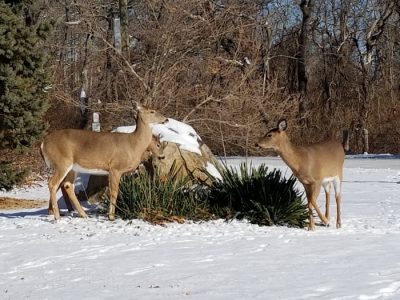
Deer are herbivores, primarily browsers, who feed on both woody and herbaceous plants. They consume an average of 5-15 lbs./day of leaves, shoots, twigs, lichens, and fruit. When a preferred food source, such as acorns, corn, or hay, is abundant, they will eagerly devour it, but when favored vegetation is unavailable, deer will eat almost anything to survive. In spring, deer seek out young, tender new growth emerging from the ground, as they prefer soft vegetation with a high water content, particularly delicate young flower buds. Well-fertilized and over-watered plants are often especially lush and appealing.
Deer injure and disfigure plants not only by eating leaves and stems, but also by rubbing antlers against the bark of trees. When they locate plants that they truly favor, or when food options are limited, deer may strip plants of leaves or bark. The severity of the damage depends on the season, food availability, food source, and weather conditions. Damage is most common on plants that are low-branched, easy to reach, accessible, and small or young. This behavior is particularly damaging to young trees with thin bark.
Deer will continually venture to urban and suburban landscapes to forage, especially in winter months when food is scarce. Deer can be creatures of habit; they usually frequent areas where they feel safe and the scent of other deer is evident.
Human and Ecological Threats from High Deer Population
With hunting prohibited in many CT municipalities, the high population of deer has become an extensive problem. The surplus population of deer in suburban and urban locations may present a challenge for landscape maintenance and has the potential to impact the health and safety of school children, teachers, and staff.
Deer are the primary host of the adult Blacklegged or Deer Tick (Ixodes scapularis) that transmits diseases, including Lyme, Babesiosis, and Anaplasmosis. Tick eradication options on daycare and K-8 school properties have been severely reduced, due to Connecticut’s ban on Environmental Protection Agency (EPA) registered pesticides. Discouraging deer populations on school properties is the first line of defense to reduce overall tick populations.
Forests with high populations of deer have reduced natural revegetation of desired hardwood species. Many wildflowers and flowering shrubs, including threatened or endangered species, such as trilliums and orchids, are favored as a food source by deer. Many browse-resistant plants, such as the invasive Asiatic bittersweet and Japanese barberry, have lower economic, aesthetic, and wildlife value than the species they displace. Many bird species and small mammal populations are negatively impacted by the change in forest ecosystems caused by excessive deer browse.
The most important way to discourage
deer from feeding on and disfiguring plants in the landscape is to incorporate species that deer prefer not to eat. However, no plant is completely deer proof. Deer must be redirected so that they avoid locations where their browsing is not acceptable. They need to be convinced the area is not safe and the food source to which they are drawn is unsavory.
Strategies to reduce browse damage and to protect plant material on school properties include:
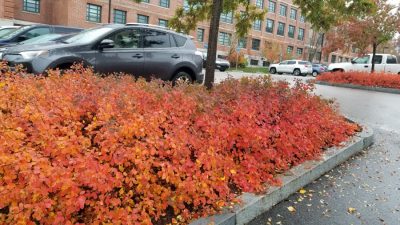
- Incorporate deer-resistant plants into the landscape. See pages 3-5 for a list of recommended plants.
- Divide the school landscape into deer feeding preference zones, prioritized by attractiveness to deer and damage potential. Plant the most browse-resistant plants along the far edge of the property where deer frequent. Plants that are the most susceptible to browse damage should be used infrequently and interspersed with deer resistant plants or grown within a fenced or protected area, such as a school courtyard.
- Shield young trees and those with thin bark by placing protective devices that discourage feeding and deer rub. Use tree protectors, plastic tree wrap, burlap, netting, or fishing line to restrict access to young or specimen plants. Wire-mesh cylinders that encircle the trunk are easy to create and install. Fishing line strung around specimen plants is a simple and inexpensive method to confuse and repel deer. Regardless of the product used, the design should not pose a hazard to children who may travel near the landscaped area.
- Use fencing to restrict deer access when possible. Fences must be at least 7-8’ high, with no more than 6” x 6” gaps, and must extend to the ground. While fencing is the best deterrent to protect plant material from deer, it may be impractical on school property settings.
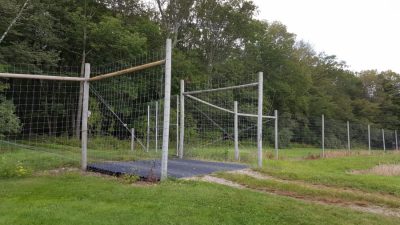
Fencing must be 7-8’ high to deter deer. - Modify fertilization of landscape plants if deer consistently travel to a specific location. Deer favor lush, well-fertilized plants, but may avoid the same plants if they are less appetizing.
- Use motion-activated lights, sprinklers, or noisemakers, where appropriate, to startle deer and cause them to flee. Success with these type of deterrents is often short-lived. Deer become accustomed to and recognize the devices if they are not moved or altered in pattern that keeps deer constantly wary.
- Annual clean-up of school property perimeters and woodline edges helps to reduce tick populations. Good sanitation along property boundaries is essential to limit the opportunity for ticks to encounter deer hosts that may travel close to areas where students frequent.
- Incorporate the use of CT Department of Energy and Environmental Protection (DEEP) approved EPA minimum risk repellents. Repellents are products that deter feeding or discourage deer browse because of an unpleasant taste or odor. They must be applied repeatedly, especially after rain events, to protect new growth as it emerges. Coverage of the plant should begin at the ground level and extend upward at least six feet. Some repellents are to be sprayed on ribbons as part of fencing kits rather than directly on plant surfaces. Due to the lingering unpleasant taste or odor, many of these repellents may not be suitable for landscape beds adjacent to school buildings. Refer to DEEP’s most current list of approved EPA minimum risk products (portal.ct.gov/DEEP/pesticides) as a resource of available products. All products used to discourage feeding must be referenced in the district’s Integrated Pest Management (IPM) plan, if placed in a school landscape. Homemade recipes are unregistered and by law are not allowed to be applied on school properties.
For more information, refer to CT.Gov and CAES.
View the pdf version of this document to learn more information about deer resistant trees, shrubs, and perennials.
Sources
- Clausen, R. (2011). 50 Beautiful Deer-Resistant Plants: The Prettiest Annuals, Perennials, Bulbs, and Shrubs that Deer Don't Eat.
Connecticut DEEP. https://portal.ct.gov/DEEP/Wildlife/Fact-Sheets/White-tailed-Deer - Glen, C. (2015). Deer Resistant Plants Recommended for Central & SE NC Landscapes. North Carolina Cooperative Extension. chatham.ces.ncsu.edu
- Glen, C. (2018). Minimizing Deer Damage [Powerpoint]. North Carolina Cooperative Extension. gardening.ces.ncsu.edu
- Kilpatrick, H., Labonte, A. & Stafford, K. (2014). The Relationship Between Deer Density, Tick Abundance, and Human Cases of Lyme Disease in a Residential Community. Journal of Medical Entomology, (51)4, 777–784. Evaluation of Deer-Targeted Interventions on Lyme Disease Incidence in Connecticut - PMC
- New York State Department of Environmental Conservation. (2018). Community Deer Management Guide. www.dec.ny.gov
- Perdomo, P., Nitsche, P., & Drake, D. Landscape Plants Rated by Deer Resistance. Rutgers Cooperative Research and Extension. njaes.rutgers.edu/deerresistance
- Stafford, K., & Williams, S. (2014). Deer, Ticks, and Lyme Disease: Deer Management as a Strategy for the Reduction of Lyme Disease. Connecticut Agricultural Experiment Station. beaconfalls-ct.org
- Wallace, V. & Siegel-Miles, A. (2020). Connecticut Native Plant and Sustainable Landscaping Guide. UConn Extension. ipm.uconn.edu.
- Ward, J. S. 2000. Limiting Deer Browse Damage to Landscape Plants. Connecticut Agricultural Experiment Station. wiltonct.org
- Williams, S. C., Ward, J. S., & Ramakrishnan, U. (2006). Deer Damage Management Options. Connecticut Agricultural Experiment Station Bulletin 1005 15p. portal.ct.gov
Questions? Contact:
Vickie Wallace
UConn Extension
Extension Educator
Sustainable Turf and Landscape
Web: ipm.uconn.edu/school
Photos by Alyssa Siegel-Miles and Victoria Wallace.
UConn Extension is committed to providing equal access and full participation for individuals with disabilities within all our programs and activities. Visit s.uconn.edu/accessibility for more resources. UConn is an equal opportunity program provider and employer.
Funds to support the creation of this document were provided by the Crop Protection and Pest Management Extension Implementation Program [grant no. 2017-70006-27201/project accession no. 013777] from the USDA National Institute of Food and Agriculture.
©UConn Extension. All rights reserved.
Updated March 2022.
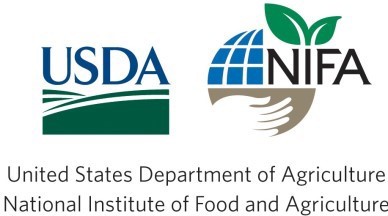 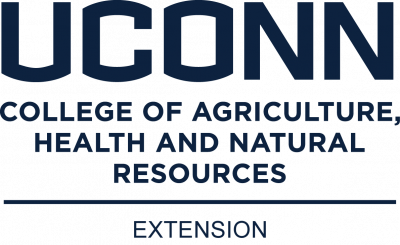 |